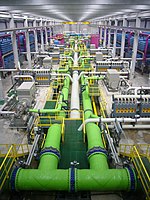
The effect of phosphonate-based antiscalant on gypsum precipitation kinetics and habit in hyper-saline solutions: An experimental and modeling approach to the planned Red Sea – Dead Sea Project
Sign Up to like & getrecommendations! Published in 2020 at "Desalination"
DOI: 10.1016/j.desal.2020.114638
Abstract: Abstract The effect of phosphonate-based antiscalant on the precipitation kinetics of gypsum under the hyper-saline solutions relevant to the Red Sea-Dead Sea desalination project was studied. Batch experiments were carried out to determine the effect… read more here.
Keywords: based antiscalant; effect phosphonate; sea; precipitation kinetics ... See more keywords

A comparative study of RO membrane scale inhibitors in wastewater reclamation: Antiscalants versus pH adjustment
Sign Up to like & getrecommendations! Published in 2020 at "Separation and Purification Technology"
DOI: 10.1016/j.seppur.2020.116549
Abstract: Abstract Scaling is the most common challenge that reverse osmosis (RO) membranes encounter in potable reuse applications due to the high product recovery. Usage of antiscalants or pH adjustment can suppress scale formation on membranes… read more here.
Keywords: calcium carbonate; membrane; scale; phosphonate based ... See more keywords

Overview of the Synthesis of Salts of Organophosphonic Acids and Their Application to the Management of Oilfield Scale
Sign Up to like & getrecommendations! Published in 2017 at "Energy & Fuels"
DOI: 10.1021/acs.energyfuels.7b00708
Abstract: Phosphonate-based scale inhibitors (SIs) have been used in the oil industry for decades. They are excellent inhibitors particularly of Group II sulfate scales and offer several advantages over other classes of oilfield SIs that contain… read more here.
Keywords: organophosphonic acids; overview synthesis; salts organophosphonic; phosphonate based ... See more keywords

Solvated Structure of Cellulose in a Phosphonate-Based Ionic Liquid
Sign Up to like & getrecommendations! Published in 2017 at "Macromolecules"
DOI: 10.1021/acs.macromol.7b01138
Abstract: We investigated the solvated structure of cellulose in a phosphonate-based ionic liquid (IL) solution utilizing scattering experiments and all-atom molecular dynamics (MD) simulations. Based on the high-energy X-ray total scattering experiment and MD simulations, a… read more here.
Keywords: cellulose; phosphonate based; structure cellulose; cellulose phosphonate ... See more keywords

Flame Retardant-Functionalized Cotton Cellulose Using Phosphonate-Based Ionic Liquids
Sign Up to like & getrecommendations! Published in 2020 at "Molecules"
DOI: 10.3390/molecules25071629
Abstract: Cellulose from cotton fibers was functionalized through a dissolution–regeneration process with phosphonate-based ionic liquids (ILs): 1,3-dimethylimidazolium methylphosphonate [DIMIM][(MeO)(H)PO2] and 1-ethyl-3-methylimidazolium methylphoshonate [EMIM][(MeO)(H)PO2]. The chemical modification of cellulose occurred through a transesterification reaction between the methyl… read more here.
Keywords: cellulose; phosphonate based; phosphonate; ionic liquids ... See more keywords